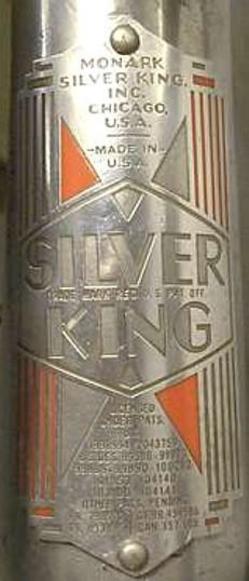

But whether driven by unbridled creative passion or a need to make up financial setbacks, he showed zero signs of slowing down. and “Presto” brand), George Lewis was 64 years old. When the Speed-O-Byke debuted in 1932 (under the banner of the Metal Specialties Manufacturing Co.

#Monark silver king bicycle history crack#
Lewis also used his own largely self-taught skills as a machinist and engineer to collect a wide assortment of notable patents, covering everything from sprockets and front forks to crack hanger assemblies, lightweight metal wheel rims, and a motorcycle-inspired bicycle frame that became the “Speed-O-Byke.” He was president of Mead’s dealer-direct division (the Premier Cycle Works) purchased parts from all the top factories and partnered with the big names of the industry- Ignaz Schwinn, Horace “Huffy” Huffman, etc.

Lewis served as its sales manager and vice president, watching over the Chicago offices as well as the firm’s second HQ in Liverpool, England.Īside from a brief tangent heading up Mead’s short-lived motor car division, Lewis spent more than 30 years carefully following-and often leading- the evolution of the bicycle trade. Their new Chicago-based company, the Mead Cycle Co., became one of the first international bicycle behemoths of the new century, and George S. After heading to Chicago to work as a ticket seller at the 1893 Columbian Exposition, he eventually formed a business partnership with an old Wichita chum, James Mead, in the sale of mail order bicycles. Lewis’s Aluminumīorn in Tiffin, Ohio, in 1868, George Strong Lewis was already one of the revered elder statesman of the American bicycle industry by the time his path crossed with that of the Monark Battery Company in 1932.ĭuring his college days in Kansas, Lewis had been a noted bike racer and a member of the Wichita Bicycle Club. The company had no clear plan in place at first, but after one of their legal advisors referred them to the latest invention of a man named George Strong Lewis, the proverbial wheels of a new enterprise were set in motion. After finding success producing electric radio and automobile batteries in the 1920s, Monark (originally, it seems, based out of Kansas City) was desperate to diversify its product line as the crunch of the Depression slowed sales. The glory of our particular artifact may be faded, but the rust-speckled mint paint job, crusty handlebar tassels, blown-out balloon tires, busted headlight, and bent basket wires still have a beauty to them-carrying the ghosts of marvelous sock hops and soda fountains long since past.ĭespite the double-dose of royalty in the name, Monark Silver King was born out of the Great Depression, beginning as a side venture of the Monark Battery Company. But post-war, space-rocket tank models like the girls’ “Roadster” in our museum collection will occasionally turn up, usually cobweb-covered in someone’s shed. MSK’s early streamlined designs are scarcely seen out in the wild these days-many of them were broken down for scrap metal during World War II. of the 1890s, the Monark Silver King Company was a short-lived but innovative Chicago bicycle manufacturer that operated from the early 1930s through the 1950s. Not to be confused with the far more prominent Swedish bike maker of the same-ish name (Monark AB), nor Chicago’s earlier Monarch Cycle MFG Co. Gives faster speed, greater strength, and snappier appearance.” - advertisement for the first Monark Silver King bicycle, 1934 Aluminum alloy-much lighter than steel, but with 3 times the tensile strength, weight for weight. “Now-An Aluminum Bicycle! The same metal which made possible present-day high-speed trains and airplanes, makes the frame of the new-type SILVER KING bicycle. Made By: Monark Silver King, Inc., 6501 W. Museum Artifact: Monark Silver King “Roadster” Girls Bicycle, 1950s


 0 kommentar(er)
0 kommentar(er)
